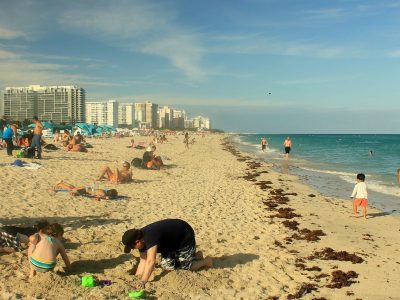Barrier Islands – An American Obsession?

Every now and then my attention is drawn to a paper in a relatively high-ranked journal that deserves comment. I would like to thank Pat Hesp on this occasion. He alerted me to a paper in Marine Geology entitled “Is barrier island morphology a function of tidal and wave energy?” (2017, v.387, 74-84; authors J. Mulhern, C. Johnson, and J. Martin).
The paper builds on the work of Miles Hayes and others in an analysis of what they term barrier “island” shape to tidal range and wave height and defined coastal energy regimes ( wave-dominated, mixed energy and tide-dominated). A global database was assembled from a range of sources including Google Earth, TPXO Tidal Model, WaveWatch III and Koppen-Gieger Climate Map (Table 1). In Figure 2 they provide a world map showing global distribution of mapped islands and spits included in the analysis. After all this they conclude that “while energy regime distinctions can be used descriptively, their utility in predicting and constraining island shape is limited”. It is suggested that their work offers “empirical scaling relationships for the first time, with implications for subsurface prediction”. They go further in the concluding section of the paper and say this analysis “highlights the likelihood of a larger number of controlling variables in shaping barrier islands such as sediment supply, substrate…” etc. As a result the original hypothesis of Hayes is quite limited.
I took the liberty of sharing my concerns with a number of colleagues. They raised various issues such as quality of peer review especially for a paper dealing with global processes and landforms; the level of scholarship required in testing a global hypothesis such as that of Hayes; the narrowness of morphometric studies of landforms; limitations of using Google Earth without back up references to local sources; failure to clearly define the types of barrier features in a classification scheme that formed the basis of their database; and a fixation on barrier islands presumably flowing from the east and Gulf coast USA work of Hayes and others. I do not intend to go into a detailed critique and suggest those interested examine the paper for themselves. But you have to wonder about a paper which shows a map of “islands and spits” down the east coast of Australia from southern Queensland to Gippsland as a continuous line but nowhere else in Australia. If their source was Roy et al. 1994 (incorrectly cited as 1997) then they failed to see how this work relied mostly on our work on “bay barriers” not barrier islands or spits.
The authors recognised that a variety of regional factors contribute to barrier island morphology in addition to global processes mentioned by Hayes (p.79), even citing Roy et al. as one of the references. However, I was surprised they did not appreciate the significance of different types of barrier behaviour in relation to factors mentioned. A useful list of references is provided on the factors. There are now several models based on morphostratigraphies that highlight the relative importance of these factors in different cases that raise a deeper set of questions on the dynamics a barrier evolution in the future. In this connection it was disappointing not to see reference to work of Chris Kraft on transgressive barriers in eastern USA. He helped me understand better the relationship of the many factors in the continuing nature of shoreline change for sand bodies that make up different morphostratigraphic types that I subsequently wrote about: transgressive (receded), stationary, prograded (regressive) and episodic transgressive dune ( Marine Geology , 1984, v 59). Much work has been done before and since then on sediment dynamics along depositional coasts including those at a global scale by former colleagues at the Coastal Studies Institute, LSU (Don Wright and Jim Coleman). The way they examined different delta types would be a useful way to look globally a sand and gravel barrier formation and in so doing help understand better the future behaviour of such features under climate change.
Bruce Thom
Words by Prof Bruce Thom. Please respect the author’s thoughts and reference appropriately: (c) ACS, 2018, posted 12 March 2018, for correspondence about this blog post please email austcoastsoc@gmail.com
#105


 Climate Change Adaptation in Australia – A Loss of Momentum
Climate Change Adaptation in Australia – A Loss of Momentum